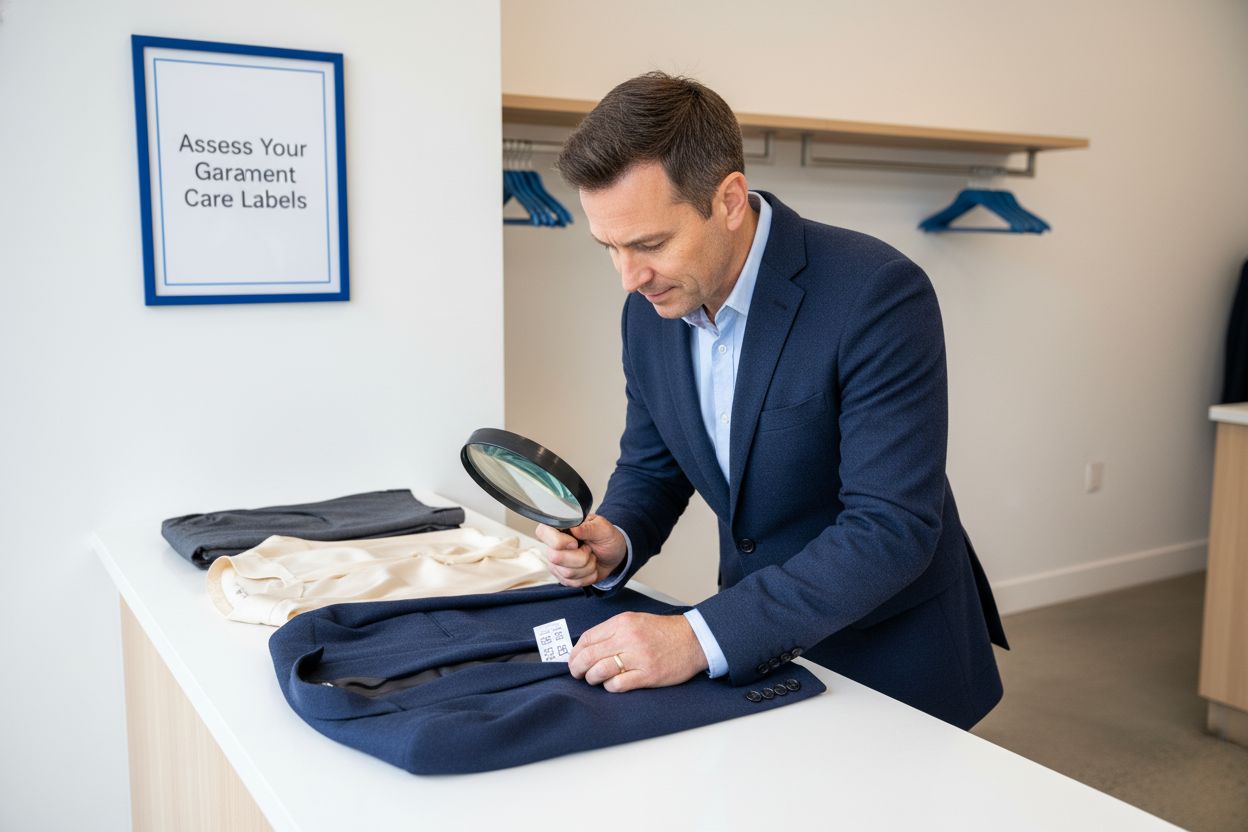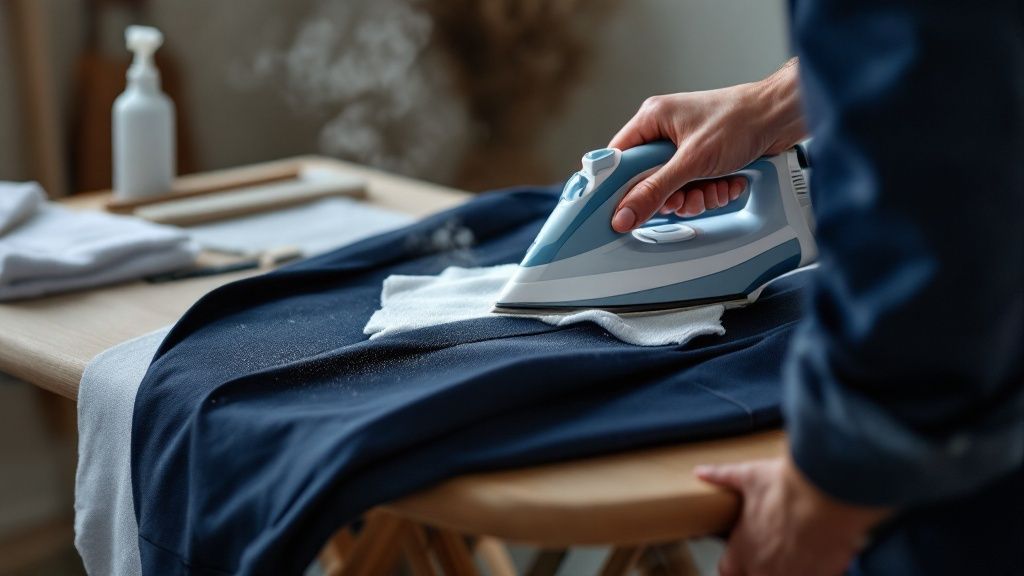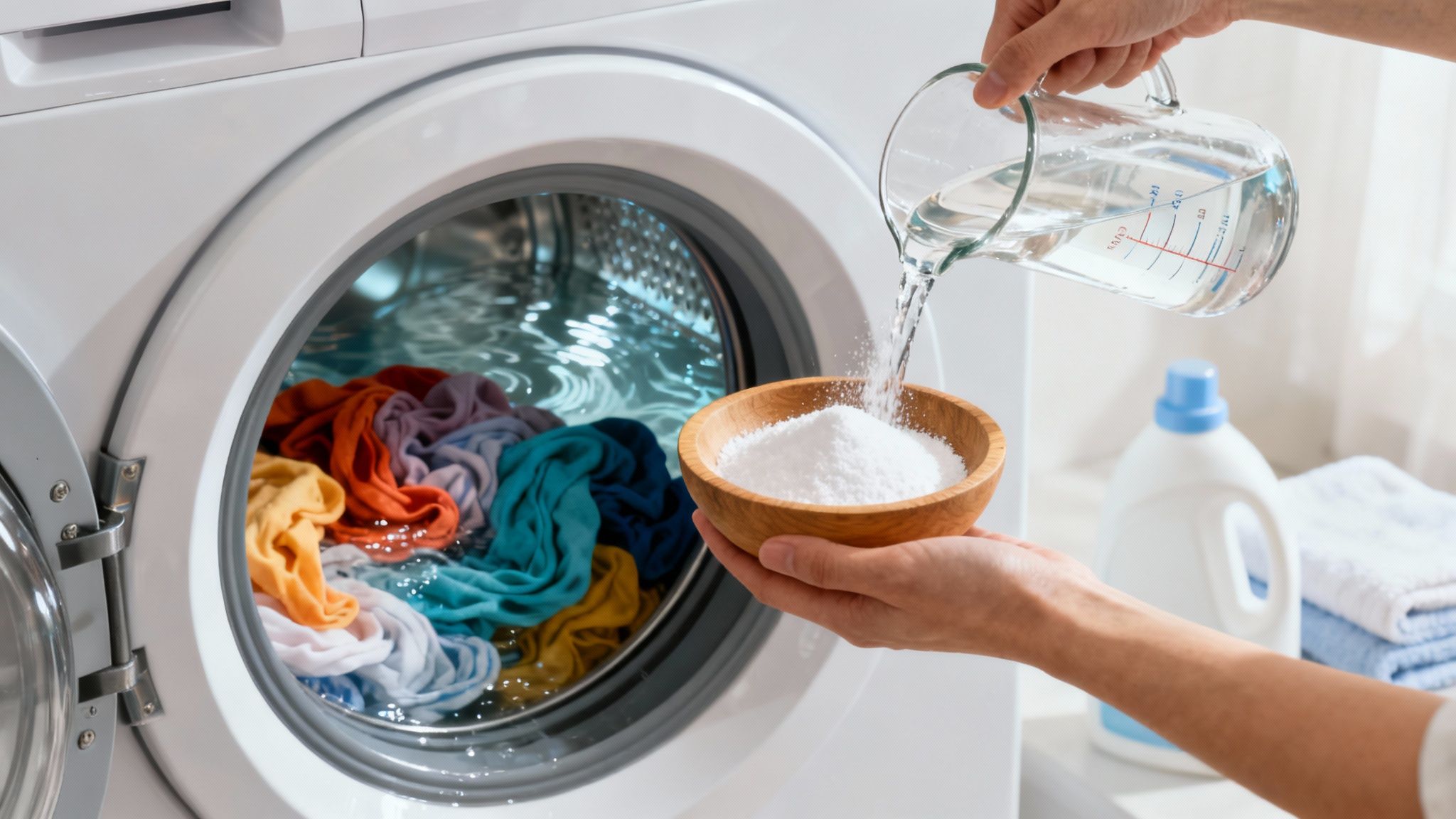How to Get Foundation Stains Out of Clothes for Good
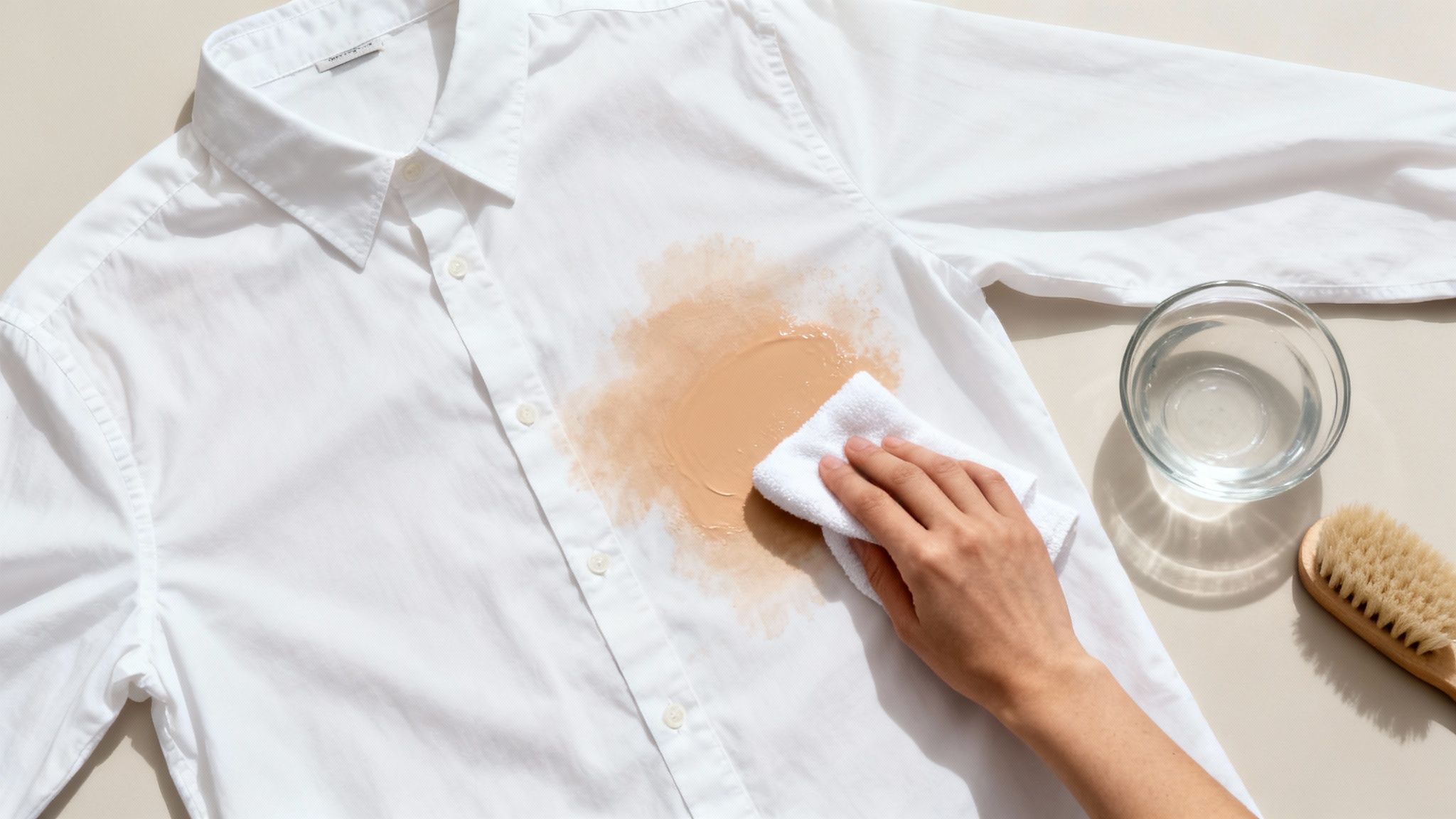
That sinking feeling when a drop of foundation lands on a clean shirt? We’ve all been there. What you do in those first few moments is everything—it's the difference between a forgotten mishap and a permanent, frustrating stain.
The golden rule is simple: act fast and never, ever scrub. Your initial goal isn't a deep clean; it's damage control. You want to lift the makeup off the fabric, not grind it deeper into the fibers.
The First 5 Minutes: What to Do Immediately
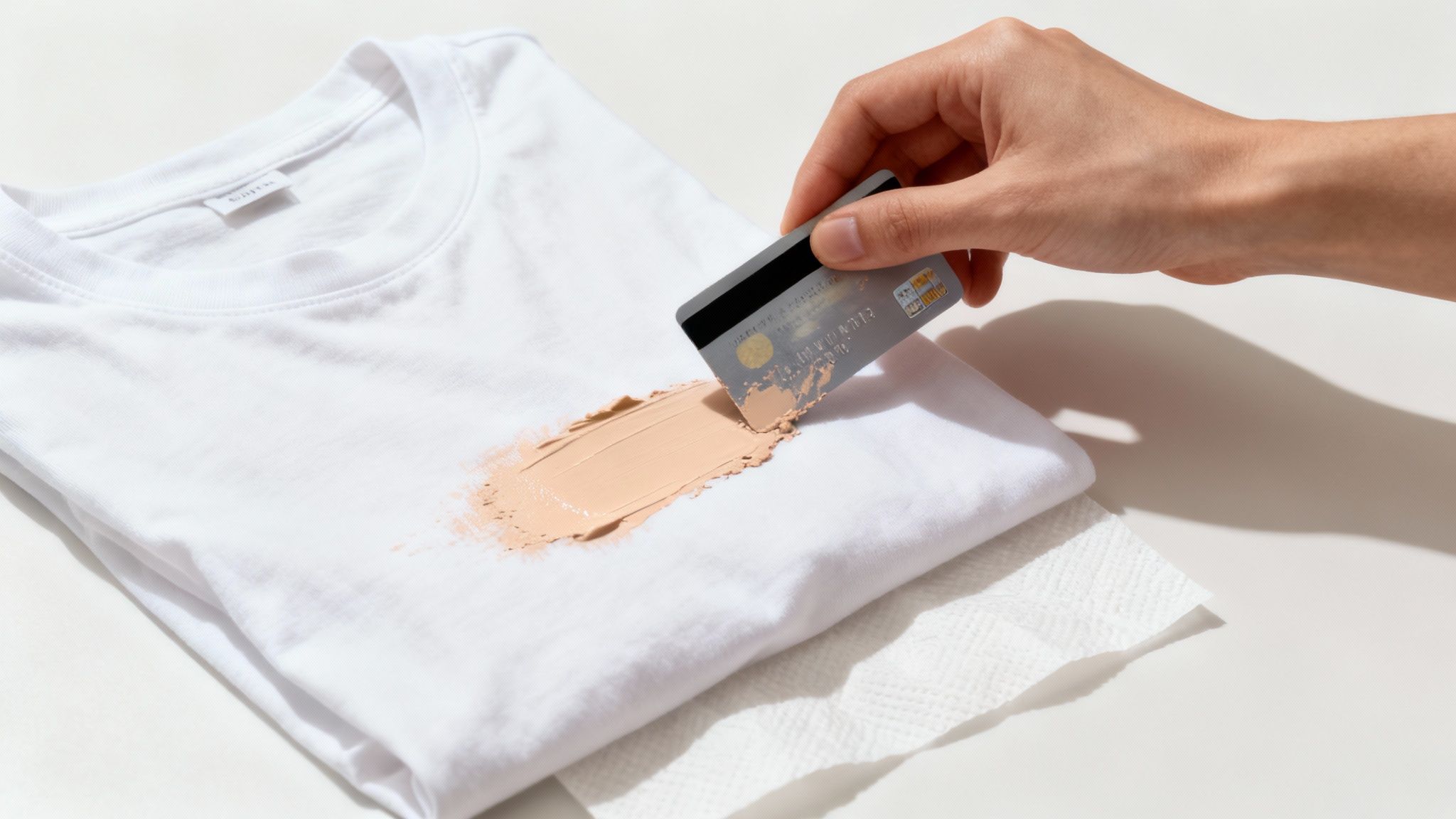
Think of it like spilling red wine on a white carpet. Your gut reaction might be to grab a wet cloth and start scrubbing wildly, but you know that only makes the mess bigger and badder. The same principle applies here.
The Scrape and Blot Method
First, find something with a dull edge—a butter knife, the side of a credit card, or even a spoon will do the trick. Gently scrape away any excess globs of foundation sitting on top of the fabric. Be gentle; you're just skimming the surface.
Next, grab a clean paper towel or a white cloth (so you can see the foundation transferring). Press it firmly onto the stain, lift it up, and then use a fresh spot on the cloth to blot again. Keep doing this until you’re not lifting much color anymore.
Key Takeaway: Whatever you do, resist the urge to use hot water at this stage. Heat is the enemy here. It can essentially "cook" the oils and proteins in the foundation, setting the stain for good. Cold water is your friend later in the process.
It’s easy to feel like a stain has ruined a favorite piece of clothing. In fact, one Canadian survey found that 42% of people have actually thrown out clothes because of stains, and 17% have skipped wearing certain items just because they were afraid of staining them. You can check out more of these relatable stats in the Ipsos survey.
But mastering this initial response is how you save your wardrobe and keep your favorite pieces in rotation, no foundation-related casualties necessary.
When panic sets in, it's easy to make a wrong move. This little cheat sheet breaks down what you should (and shouldn't) do in those critical first minutes.
Immediate Stain Response Cheat Sheet
Following these simple do's and don'ts can dramatically increase your chances of getting that stain out completely.
Choosing The Right Stain-Fighting Method
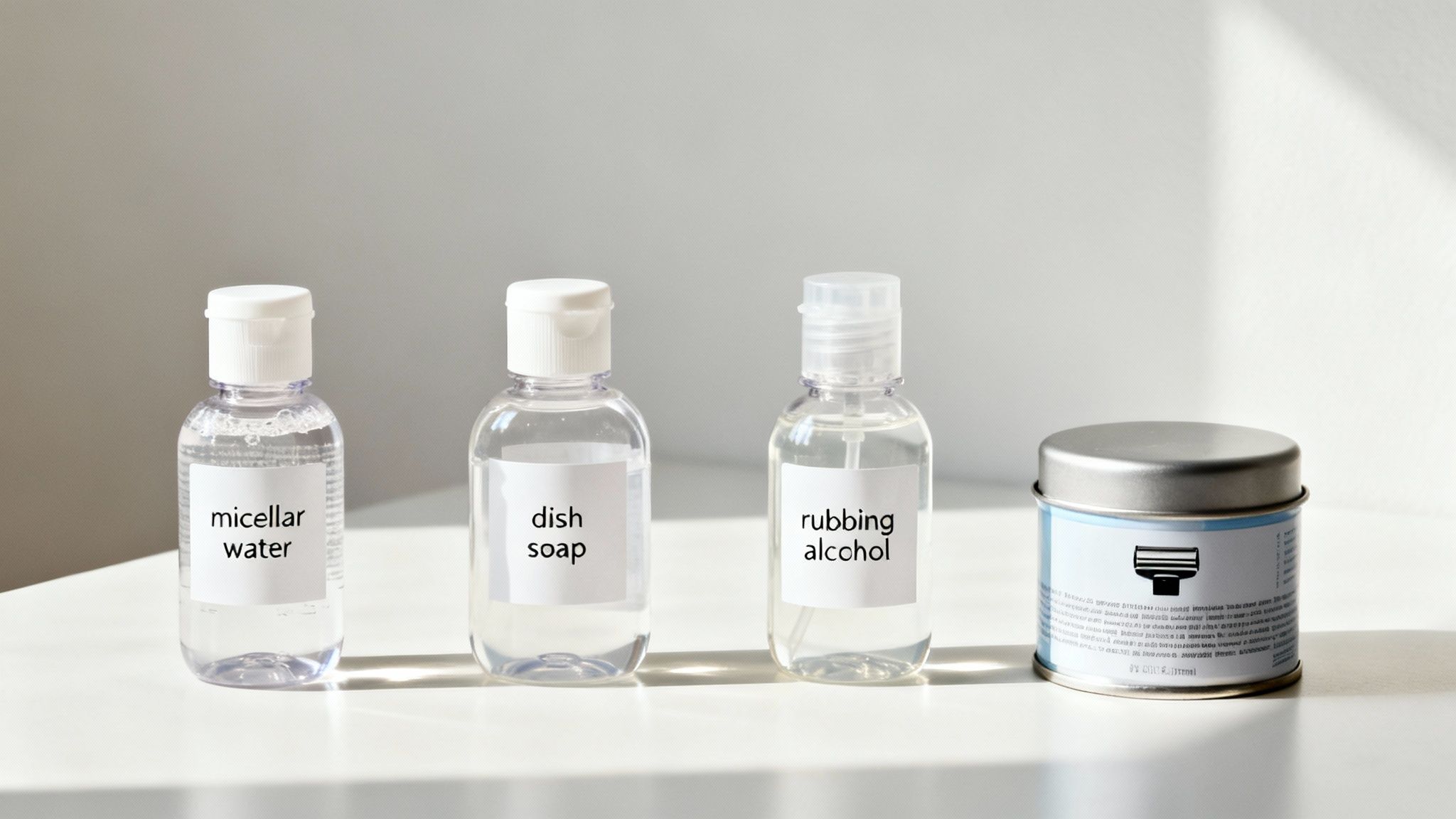
I’ve seen it a thousand times: a foundation smudge that just won't budge. The secret to getting it out isn't about scrubbing harder—it's about understanding what you're up against. Not all foundation stains are created equal, so your removal strategy can't be a one-size-fits-all approach. The key clue is right on the product label.
An oil-free, water-based foundation is the easiest culprit to deal with. These formulas are far less stubborn and usually surrender to simple solutions you already have at home. Because they don't have those heavy oils, the pigments don't lock onto fabric fibers quite so aggressively.
On the other hand, long-wear or oil-based foundations are engineered to grip your skin for hours, and believe me, they'll do the same to your clothes. These stains demand a more powerful solvent to break down the oils that are holding the pigment hostage in the fabric.
Matching Your Foundation To A Solution
When you're dealing with an oil-free formula, always start with the gentlest methods first. You might be surprised at how well they work.
- Micellar Water: This is a fantastic first line of defense. It’s made to lift makeup from your skin without harsh chemicals, and it does the same for many fabrics.
- Dish Soap: A good-quality liquid dish soap is a grease-cutting powerhouse. It's designed to break down oils from food, so it can easily tackle the components of a water-based makeup stain.
- Shaving Cream: This is a classic household hack for a reason. Shaving cream contains surfactants, much like soap, that help lift the stain right out of the fibers. Just apply a small amount, let it sit for a few minutes, then gently blot it away.
For those tough, oil-based formulas, you need to call in the heavy hitters. These products are specifically formulated to dissolve oily, waxy messes.
A common mistake is using the same gentle approach for every stain and getting frustrated when it doesn't work. By matching your method to the foundation type, you save time and are far more likely to see success on the first try. Understanding https://www.columbiapikelaundry.com/post/how-stain-removers-work-for-every-stain-type is crucial.
Advanced Options and Final Steps
When dish soap just isn’t enough, rubbing alcohol is an excellent solvent for oil-based makeup. Just be sure to test it on a hidden spot first—like an inner seam—as it can be too harsh for some delicate fabrics. Apply it sparingly with a cotton ball and blot gently; never rub.
This focus on effective cleaning agents is part of a bigger picture. The global stain remover market is projected to hit an incredible USD 38.46 billion by 2033. This growth is fueled by new innovations in fabric care and a rising demand for eco-friendly products that are changing how we all treat stains.
Finally, don't forget the last step: the laundry detergent you use in the final wash really matters. After pre-treating the spot, a quality detergent provides the cleaning power needed to wash away any leftover residue. For those with sensitive skin or environmental concerns, looking into options like phosphate-free laundry detergents can also make a significant difference.
Your Stain Removal Playbook from Start to Finish
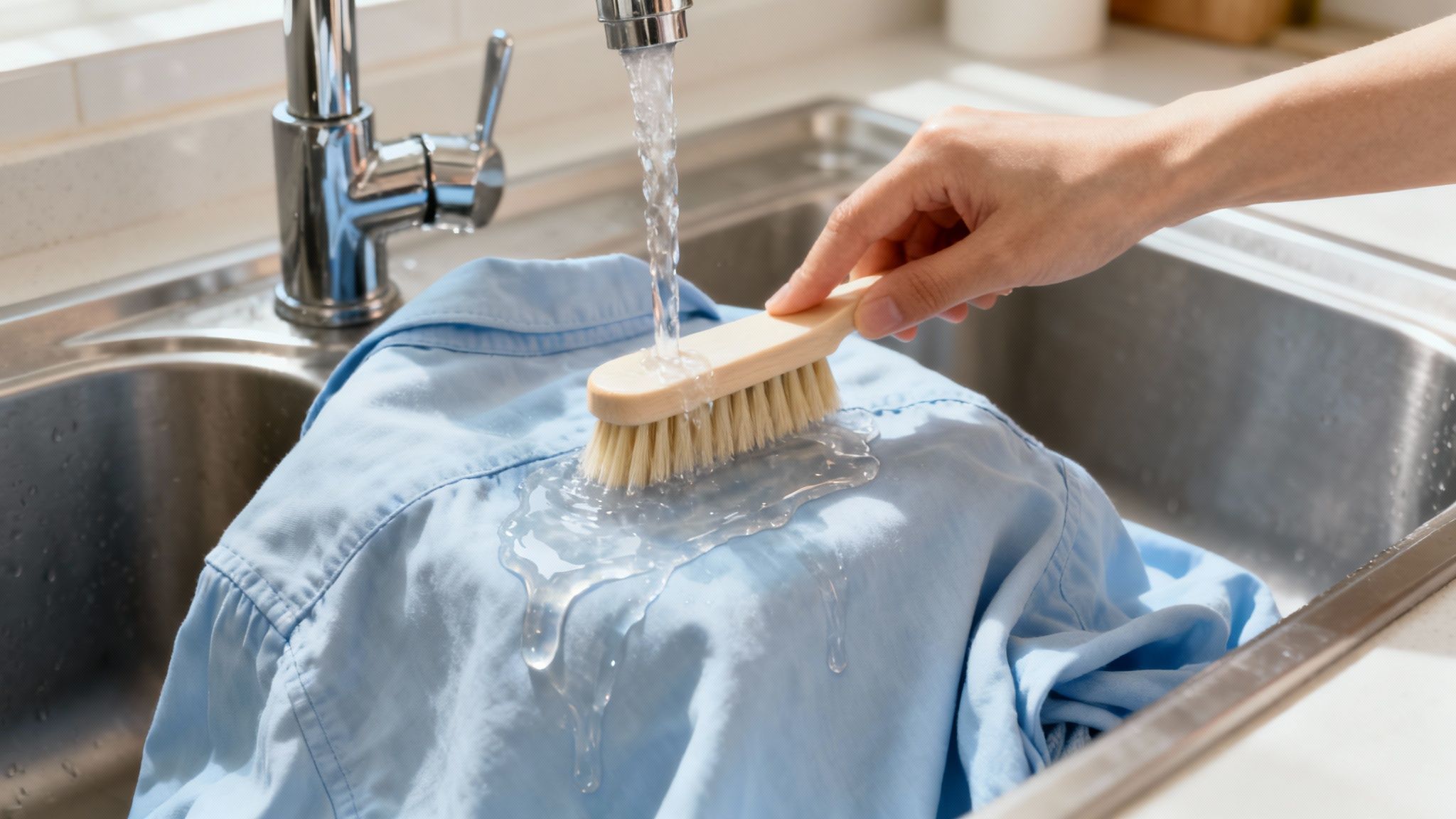
Alright, you’ve picked your weapon of choice. Now it's time to get that stain out. Remember, the right technique is just as crucial as the product you’re using, and a little bit of patience goes a long way here. Think of this less like a battle and more like a careful operation.
Go ahead and apply your chosen solution directly onto the foundation stain. Whether it's dish soap, shaving cream, or a dab of rubbing alcohol, just use enough to cover the spot completely. Then, walk away. Seriously. Let it sit for at least 10-15 minutes. This is where the magic starts—the cleaner needs that time to work its way into the fabric and start breaking down all the oils and pigments in the makeup.
Gently Working the Stain
Once the solution has had time to soak in, you can start the hands-on part. Grab a soft-bristled toothbrush (an old one is perfect for this) or just use your fingertip to gently work the cleaner into the stain. I find that small, circular motions or a light dabbing technique works best. The goal is to lift the stain away, not to scrub it deeper into the fabric's weave.
It's funny how some stain removal tricks never change. Pre-treating and soaking are still the cornerstones of getting out tough marks. The methods for removing foundation often look a lot like those for other stubborn pigments, like face paint, which can also be oil- or water-based. That classic process of scraping off the excess, blotting, and then applying a specific cleaner is a pretty universal approach for a reason—it works. You can actually see some similar makeup stain removal strategies from COIT that follow this same logic.
Here’s a pro tip that makes a huge difference: always rinse the stain from the back of the fabric. Flip the garment over and run cold water through the back of the stain. This pushes the foundation gunk out of the fibers, instead of driving it further in.
The Final Wash and Critical Check
Now you're ready to let the washing machine take over. Just be sure to follow the garment's care label and stick to a cold water cycle. Hot water is still the enemy at this stage; any makeup left behind could be permanently set by the heat.
This last step is probably the most important one. Once the wash cycle finishes, take the item out and give it a thorough inspection in good light. If you see even a faint hint of that foundation mark, it's time for round two. Repeat the pre-treatment and washing process. Whatever you do, don't toss it in the dryer yet. The heat from a dryer will lock in any remaining stain, making it nearly impossible to ever get out.
Only when you’re 100% sure the stain is gone should you dry the item as you normally would.
Treating Stains on Delicate and Tricky Fabrics
That technique that works wonders on your favorite cotton t-shirt could spell disaster for a silk blouse or wool sweater. Getting foundation out of delicate fabrics requires a completely different—and much gentler—approach. Materials like silk, wool, and rayon just don't react well to aggressive chemicals or vigorous rubbing, which can permanently damage their fragile fibers.
Think of it this way: you wouldn't use a harsh kitchen scrubber on a fine piece of china, right? The same logic applies here. These fabrics have unique structures that are easily disrupted, which can lead to stretching, fading, or even holes if you get too aggressive. The key is to work with the fabric, not against it.
Gentle Solutions for Sensitive Materials
Before you even think about touching that stain with a cleaner, you absolutely must spot-test on a hidden area. I’m talking about an inner seam or the hem. This is a non-negotiable step that ensures your chosen method won't cause discoloration or further damage.
Once you’ve done your spot test, here are a few gentler alternatives for specific fabrics:
- Silk: A diluted solution of equal parts white vinegar and water can be your best friend. Apply it sparingly with a clean white cloth, dabbing very gently at the stain.
- Wool: Look for a pH-neutral detergent, often sold as a "wool wash." Mix just a tiny amount with cool water and carefully blot the area. Make sure to avoid any product with enzymes, as they can literally break down the protein fibers in the wool.
- Rayon: This fabric gets notoriously weak when it’s wet, so you have to handle it with extreme care. Your safest bet is a small dab of mild dish soap on a damp cloth.
The most crucial advice for delicate fabrics is this: when in doubt, do less. A faint, lingering mark is always better than a hole or a bleached-out spot from a treatment that was too harsh. Patience is your most valuable tool here.
Sometimes, a stain is just too risky or stubborn to tackle at home. Professional services have access to specialized solvents and techniques that are much safer for high-value or delicate garments. Understanding how dry cleaners remove stains can help you decide when it's time to call in the experts instead of risking a beloved piece of clothing.
How to Tackle Old Set-In Foundation Stains

We've all been there. You pull your favorite blouse out of the laundry, only to spot a foundation stain that somehow survived the wash and the dryer. That sinking feeling is real. The dryer's heat essentially bakes the oils and pigments into the fabric, making it a much tougher opponent than a fresh smudge.
But don't toss that shirt just yet. While this situation calls for more muscle than a simple spot treatment, it’s not a lost cause. Forget aggressive scrubbing—that won't do much here. Instead, you need to think about a deep, patient treatment. A good commercial stain remover designed specifically for set-in stains is a great place to start, as they pack powerful solvents that work to re-liquefy and lift those stubborn marks.
Creating a Soaking Paste
If you’d rather go the DIY route, you can mix up a potent paste right in your kitchen. Just combine baking soda with a little water until you have a thick, spreadable consistency. Slather it liberally over the entire stain and let it sit for several hours, or even overnight. This gives the alkaline baking soda plenty of time to work its magic and break down the stain's components.
For really tough jobs on durable fabrics, some people have had incredible success with laundry stripping. This is a more intense soaking method that uses powerful agents to pull out deep-set grime. You can learn more about using ingredients like Borax for an effective laundry strip to see if it's the right move for your garment.
Important Note: On white or colorfast fabrics only, hydrogen peroxide can be your last line of defense. Dab it directly onto the stain, let it bubble for a few minutes, and then rinse the area thoroughly with cold water before you try washing it again.
Once your chosen treatment has had time to sit, gently work it into the fabric with your fingers or a soft brush. Then, run the item through another cold wash cycle. The most important part? Check the garment carefully for any lingering discoloration before it goes anywhere near the dryer again. Sometimes, it takes a second or even a third round to completely knock out an old foundation stain. Patience is key
Common Foundation Stain Questions Answered
When you're frantically trying to figure out how to get a foundation stain out of a favorite shirt, a few questions always seem to pop up. Let's tackle them head-on so you can act quickly and confidently the next time a makeup mishap occurs.
Does Shaving Cream Really Work?
Believe it or not, this popular hack can work wonders, but there's a catch. Shaving cream is basically an aerated soap loaded with surfactants, which are fantastic at lifting stains.
It’s most effective on oil-free foundations. For these, the shaving cream can break down the pigments without having to fight through a layer of heavy oils. Just apply a small dollop, let it sit for a few minutes, then gently blot and rinse with cold water.
Can I Use Makeup Remover Wipes on Clothes?
Makeup remover wipes can be a decent first line of defense for a tiny, fresh smudge. I mean, they're designed to lift makeup from your face, so the logic holds up.
Use them with caution, though. Many wipes have oils or moisturizers in them to be gentle on your skin, and those ingredients can leave a new, even more stubborn oily stain on your garment. If you're going to try it, it's always best to test on a hidden seam first.
Honestly, prevention is always the best strategy. A few simple habits can make a huge difference in avoiding stains altogether, saving you a lot of time and stress down the road.
Here are a few quick prevention tips I swear by:
- Use a setting spray to lock your makeup in place.
- Let your foundation dry completely before you even think about getting dressed.
- Drape a scarf or cloth over your head when pulling on shirts to act as a shield. It might look silly for a second, but it works!
Beyond just dealing with the stain, understanding the product itself, like knowing how to choose the right foundation shade, can sometimes help you select formulas that are less likely to transfer in the first place.
If you're facing a stain that just won't budge, or if you'd simply rather leave it to the experts, Columbia Pike Laundry is here to help. We give you back your time and peace of mind. Schedule a pickup today and let us handle the rest.
Popular Blog Articles

Meet the Author
Daniel Logan didn’t start CPL because he loved laundry. He started it because his family was drowning in time debt, and laundry was one of the biggest weights.
Mornings were chaos with two kids under 5. Evenings felt like catch-up. And weekends? Gone to sorting socks and folding piles.
He knew his story wasn’t unique. So he built a business that gave families like his just a little bit of breathing room one load at a time.
With no laundry experience but deep tech skills, Daniel rolled up his sleeves, doing every job himself while building systems that turned it into a modern laundry service that saves customers time, simplifies their lives, and delivers reliability they can count on.
That’s where CPL began. Not from a playbook, but from pain. From one dad trying to buy back time: for himself, and for every household like his.



